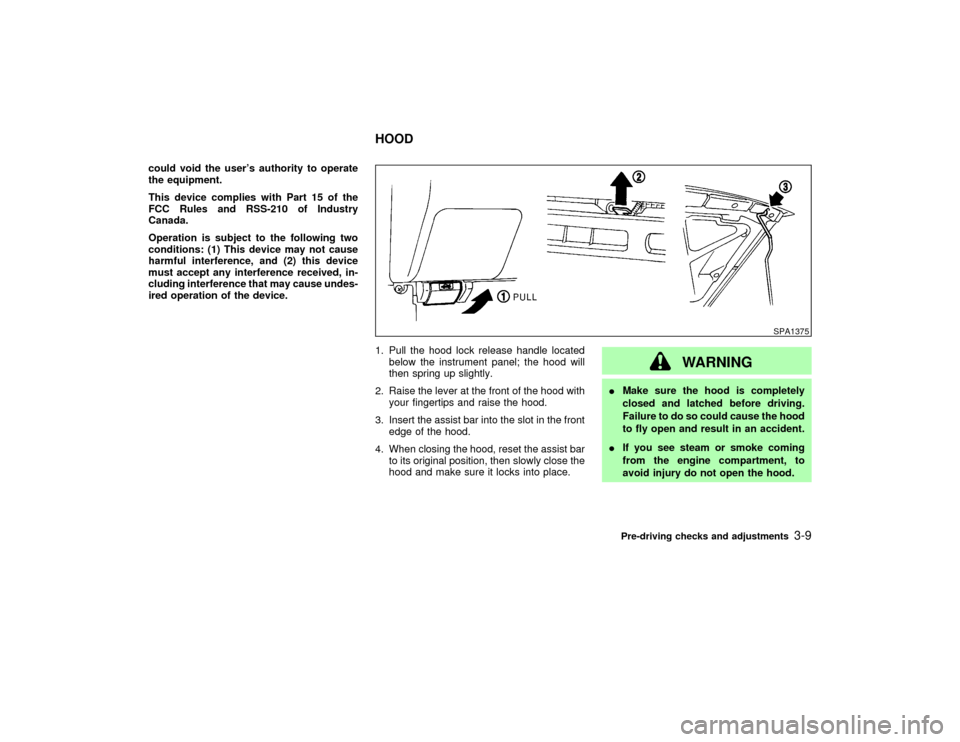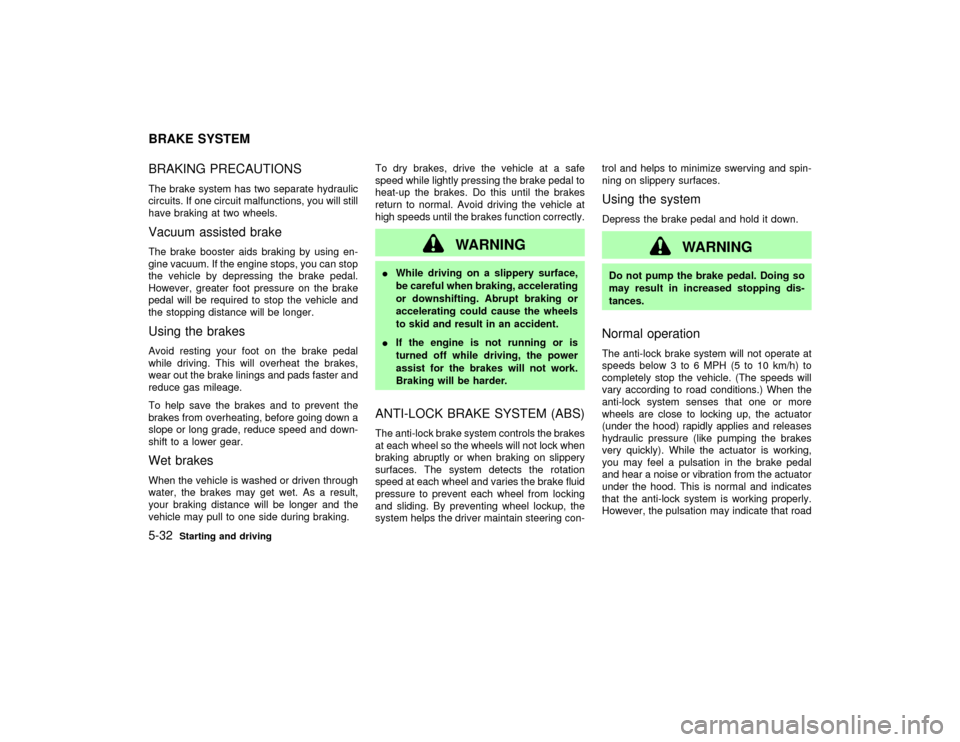2002 NISSAN PATHFINDER hood release
[x] Cancel search: hood releasePage 55 of 288

Driver's supplemental air bag (P.1-10)Cruise control
switch (P.5-17)
Outside mirror remote control
(P.3-15) Headlight/dimmer/turn signal switch (P.2-19)
Front fog light switch (P.2-23)
Steering switch for audio control
(P.4-30)Meters/gauges (P.2-3)Windshield
and rear
window wiper/
washer
switch
(P.2-18)
Hazard warning
flasher switch
(P.2-23)Center ventilator (P.4-2)
Heater/air conditioner control (P.4-2)Compass/outside air temperature display (P.2-6)
Passenger supplemental air bag (P.1-10)
Side ventilator (P.4-2)
Glove box (P.2-29)
Power outlet (P.2-25) or Cigarette lighter (P.2-26)
Radio (P.4-11)/CD player (P.4-13) or Navigation system* Glass hatch/
outside mirror
defogger switch
(P.2-19) Ignition switch/steering
lock (P.5-6)
Heated seat switch (P.2-24)
or 4WD shift switch (P.5-24) Tilting steering wheel
adjust lever (P.3-14) Fuse box cover (P.8-28)/
Tray (P.2-27)Clock (P.2-25)
Instrument brightness control
(P.2-21)
SIC1438
See the page indicated in parentheses for operating details.
*: Refer to the separate Navigation System Owner's Manual.
Security indicator
light (P.2-15)
Hood release handle (P.3-9)Heated seat switch (P.2-24) (4WD shift switch equipped models)
INSTRUMENT PANEL2-2
Instruments and controls
Z
01.9.21/R50-D/V5
X
Page 69 of 288

Security indicator lightThis light blinks whenever the ignition switch is
in the LOCK, OFF or ACC position. This
function indicates the security systems
equipped on the vehicle are operational.How to activate the vehicle security
system1. Close all windows.
The system can be activated even if the
windows are open.
2. Remove the key from the ignition switch.3. Close and lock all doors, hood, back door
and glass hatch. All doors can be locked
either with the keyfob, a key, the door lock
knob or the lock-unlock switch. See ªDoorsº
in the ª3. Pre-driving checks and adjust-
mentsº section for locking all doors simul-
taneously.
4. Confirm that the SECURITY indicator light
comes on. The SECURITY light glows for
about 30 seconds and then begins to flash.
The system is now activated. If, during this
30 second time period, the door is unlocked
by the key or keyfob, or the ignition key is
turned to ACC or ON, the system will not
activate.
IIf the key is turned slowly toward the
front of the vehicle when locking the
door, the system may not activate. If the
key is returned beyond the vertical po-
sition toward the rear of the vehicle to
remove the key, the system may be
deactivated. When the indicator light
fails to glow for 30 seconds, unlock the
door once and lock it again.
IEven when the driver and/or passengers
are in the vehicle, the system will acti-
vate with all doors, hood, back door and
back door glass hatch locked and igni-
tion key off. Turn the ignition key to ACCto turn the system off.
Vehicle security system operationThe vehicle security system will give the fol-
lowing alarm:
IThe headlights blink and the horn sounds
intermittently.
IThe alarm automatically turns off after 1
minute, however, the alarm will reactivate if
the vehicle is tampered with again.
The alarm is activated by:
IUnlocking the door, back door or back door
glass hatch without using the key or keyfob.
(Even if the door is opened by releasing the
door inside lock knob, the alarm is acti-
vated.)
IOpening the hood. (Even if the hood is
opened by the hood release handle, the
alarm is activated.)
IOpening the back door glass hatch.
IConnecting the battery connector after it
has been disconnected from the battery for
more than 1 second.How to stop alarmThe alarm will stop only by unlocking a door,
the back door or the back door glass hatch
SIC1442
2-16
Instruments and controls
Z
01.9.21/R50-D/V5
X
Page 108 of 288

could void the user's authority to operate
the equipment.
This device complies with Part 15 of the
FCC Rules and RSS-210 of Industry
Canada.
Operation is subject to the following two
conditions: (1) This device may not cause
harmful interference, and (2) this device
must accept any interference received, in-
cluding interference that may cause undes-
ired operation of the device.
1. Pull the hood lock release handle located
below the instrument panel; the hood will
then spring up slightly.
2. Raise the lever at the front of the hood with
your fingertips and raise the hood.
3. Insert the assist bar into the slot in the front
edge of the hood.
4. When closing the hood, reset the assist bar
to its original position, then slowly close the
hood and make sure it locks into place.
WARNING
IMake sure the hood is completely
closed and latched before driving.
Failure to do so could cause the hood
to fly open and result in an accident.
IIf you see steam or smoke coming
from the engine compartment, to
avoid injury do not open the hood.
SPA1375
HOOD
Pre-driving checks and adjustments
3-9
Z
01.9.21/R50-D/V5
X
Page 181 of 288

BRAKING PRECAUTIONSThe brake system has two separate hydraulic
circuits. If one circuit malfunctions, you will still
have braking at two wheels.Vacuum assisted brakeThe brake booster aids braking by using en-
gine vacuum. If the engine stops, you can stop
the vehicle by depressing the brake pedal.
However, greater foot pressure on the brake
pedal will be required to stop the vehicle and
the stopping distance will be longer.Using the brakesAvoid resting your foot on the brake pedal
while driving. This will overheat the brakes,
wear out the brake linings and pads faster and
reduce gas mileage.
To help save the brakes and to prevent the
brakes from overheating, before going down a
slope or long grade, reduce speed and down-
shift to a lower gear.Wet brakesWhen the vehicle is washed or driven through
water, the brakes may get wet. As a result,
your braking distance will be longer and the
vehicle may pull to one side during braking.To dry brakes, drive the vehicle at a safe
speed while lightly pressing the brake pedal to
heat-up the brakes. Do this until the brakes
return to normal. Avoid driving the vehicle at
high speeds until the brakes function correctly.
WARNING
IWhile driving on a slippery surface,
be careful when braking, accelerating
or downshifting. Abrupt braking or
accelerating could cause the wheels
to skid and result in an accident.
IIf the engine is not running or is
turned off while driving, the power
assist for the brakes will not work.
Braking will be harder.ANTI-LOCK BRAKE SYSTEM (ABS)The anti-lock brake system controls the brakes
at each wheel so the wheels will not lock when
braking abruptly or when braking on slippery
surfaces. The system detects the rotation
speed at each wheel and varies the brake fluid
pressure to prevent each wheel from locking
and sliding. By preventing wheel lockup, the
system helps the driver maintain steering con-trol and helps to minimize swerving and spin-
ning on slippery surfaces.
Using the systemDepress the brake pedal and hold it down.
WARNING
Do not pump the brake pedal. Doing so
may result in increased stopping dis-
tances.Normal operationThe anti-lock brake system will not operate at
speeds below 3 to 6 MPH (5 to 10 km/h) to
completely stop the vehicle. (The speeds will
vary according to road conditions.) When the
anti-lock system senses that one or more
wheels are close to locking up, the actuator
(under the hood) rapidly applies and releases
hydraulic pressure (like pumping the brakes
very quickly). While the actuator is working,
you may feel a pulsation in the brake pedal
and hear a noise or vibration from the actuator
under the hood. This is normal and indicates
that the anti-lock system is working properly.
However, the pulsation may indicate that road
BRAKE SYSTEM5-32
Starting and driving
Z
01.9.21/R50-D/V5
X
Page 212 of 288

Wheel nuts*:
When checking the tires, make sure no nuts
are missing, and check for any loose nuts.
Tighten if necessary.
Tire rotation*:
Tires should be rotated every 7,500 miles
(12,000 km). However, the timing for tire rota-
tion may vary according to your driving habits
and road surface conditions.
Wheel alignment and balance:
If the vehicle should pull to either side while
driving on a straight and level road, or if you
detect uneven or abnormal tire wear, there
may be a need for wheel alignment.
If the steering wheel or seat vibrates at normal
highway speeds, wheel balancing may be
needed.
For additional information regarding tires, refer
to ªImportant Tire Safety Informationº in the
Warranty Information Booklet (US) or ªTire
Safety Informationº in the Warranty Informa-
tion booklet (Canada).
Windshield:Clean the windshield on a regu-
lar basis. Check the windshield at least every
six months for cracks or other damage. Have a
damaged windshield repaired by a qualified
repair facility.Windshield wiper blades*:
Check for cracks or wear if they do not wipe
properly.
Doors and engine hood:
Check that all doors and the engine hood,
operate properly. Also ensure that all latches
lock securely. Lubricate hinges, latches, rollers
and links if necessary. Make sure that the
secondary latch keeps the hood from opening
when the primary latch is released.
When driving in areas using road salt or other
corrosive materials, check lubrication fre-
quently.
Inside the vehicleLights*:
Clean the headlights on a regular basis. Make
sure that the headlights, stop lights, tail lights,
turn signal lights, and other lights are all oper-
ating properly and installed securely. Also
check headlight aim.INTERIOR MAINTENANCEThe maintenance items listed here should be
checked on a regular basis, such as when
performing periodic maintenance, cleaning the
vehicle, etc.Warning lights and chimes:
Make sure that all warning lights and chimes
are operating properly.
Windshield wiper and washer*:
Check that the wipers and washer operate
properly and that the wipers do not streak.
Windshield defroster:
Check that the air comes out of the defroster
outlets properly and in sufficient quantity when
operating the heater or air conditioner.
Steering wheel:
Check for changes in the steering conditions,
such as excessive freeplay, hard steering or
strange noises.
Seats:
Check seat position controls such as seat
adjusters, seatback recliner, etc. to ensure
they operate smoothly and that all latches lock
securely in every position. Check that the head
restraints move up and down smoothly and
that the locks (if so equipped) hold securely in
all latched positions.
Seat belts:
Check that all parts of the seat belt system
(e.g. buckles, anchors, adjusters and retrac-
Maintenance and do-it-yourself
8-3
Z
01.9.21/R50-D/V5
X
Page 282 of 288

FM-AM radio with cassette player and Compact
Disc (CD) player ............................................. 4-14
Fog light switch ............................................... 2-23
Four wheel drive (4WD) ........................ 5-20, 5-23
4WD shift switch operations ........................... 5-26
Front air bag system (See supplemental restraint
system) ........................................................... 1-16
Front fog light switch ...................................... 2-23
Front manual seat adjustment .......................... 1-2
Front power seat adjustment ............................ 1-4
Fuel
Capacities and recommended fuel/
lubricants ..................................................... 9-2
Filler cap .................................................... 3-12
Filler lid ...................................................... 3-12
Fuel economy ............................................ 5-19
Fuel octane rating ....................................... 9-4
Fuel recommendation.................................. 9-4
Gauge .......................................................... 2-5
Fuses .............................................................. 8-27
Fusible links .................................................... 8-28
G
Gas cap .......................................................... 3-12
Gauge ............................................................... 2-3
Engine coolant temperature gauge ............. 2-4
Fuel gauge .................................................. 2-5
Odometer..................................................... 2-3
Speedometer ............................................... 2-3
Tachometer ................................................. 2-4
General maintenance ....................................... 8-2
Glass hatch and outside mirror defogger
switch .............................................................. 2-19Glass hatch lock ............................................. 3-11
Glass hatch opener ........................................ 3-11
Glasses case .................................................. 2-28
Glove box........................................................ 2-29
Glove box lock ................................................ 2-29
H
Hazard warning flasher switch........................ 2-23
Head restraints ................................................. 1-9
Headlights
Bulb replacement ...................................... 8-31
Headlight switch ........................................ 2-20
Heated seats................................................... 2-24
Heater
Engine coolant heater ............................... 5-35
Heater and air conditioner (automatic) ....... 4-8
Heater and air conditioner controls ............. 4-2
Heater operation.......................................... 4-2
Heater operation, Semiautomatic air
conditioner ........................................................ 4-4
Hood, release ................................................... 3-9
Hook, Luggage hook ...................................... 2-32
Horn ................................................................ 2-24
How to stop alarm, Vehicle security ............... 2-16
I
Ignition switch ................................................... 5-6
Automatic transmission models ......... 5-6, 5-10
Key positions ............................................... 5-8
Manual transmission models ............. 5-7, 5-14
Immobilizer system ......................................... 2-17Indicator lights................................................. 2-13
Inside mirror .................................................... 3-15
Inspection/maintenance (I/M) test................... 9-23
Instrument panel ............................................... 2-2
Interior lights ................................................... 2-38
J
Jump starting .................................................... 6-9
K
Keys .................................................................. 3-2
L
Label, Air conditioner specification label ........ 9-14
Label, Emission control information label ....... 9-14
Label, F.M.V.S.S. certification label................ 9-13
Labels
Air bag warning labels............................... 1-20
Engine serial number ................................ 9-13
Vehicle identification number (VIN)........... 9-12
Light
Air bag warning light ................................. 1-21
Bulb replacement ...................................... 8-30
Fog light switch ......................................... 2-23
Front fog light switch ................................. 2-23
Headlight switch ........................................ 2-20
Headlights Bulb replacement .................... 8-31
Interior lights .............................................. 2-38
Personal lights ........................................... 2-39
Replacement ............................................. 8-30
Z
01.9.21/R50-D/V5
X
10-3
Page 288 of 288

Engine coolant 8-9
Engine oil 8-13
Power steering fluid
(VG33E) 8-18
Brake fluid 8-18
Clutch fluid 8-19
Meters and gauges 2-3
Seat belt 1-22
Door lock 3-2
Rear door lock 3-10
Fuel 3-12, 9-2
Spare tire 6-3 Hood release 3-9Window washer fluid 8-20
Battery 8-21
Automatic transmission
fluid 8-16
Air conditioner 4-2
Audio system 4-11
STI0232
Power steering fluid
(VQ35DE) 8-18
Z
01.9.21/R50-D/V5
X